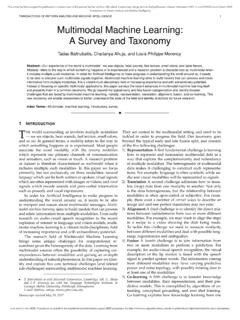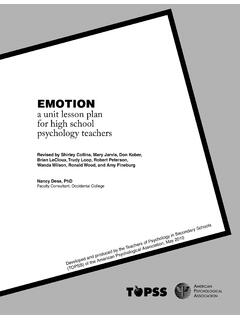Transcription of Emotion Detection Through Facial Feature Recognition
1 Emotion Detection Through Facial Feature Recognition James Pao Abstract Humans share a universal and fundamental set of emotions which are exhibited Through consistent Facial expressions. An algorithm that performs Detection , extraction, and evaluation of these Facial expressions will allow for automatic Recognition of human Emotion in images and videos. Presented here is a hybrid Feature extraction and Facial expression Recognition method that utilizes Viola-Jones cascade object detectors and Harris corner key-points to extract faces and Facial features from images and uses principal component analysis, linear discriminant analysis, histogram-of-oriented-gradients (HOG) Feature extraction, and support vector machines (SVM) to train a multi-class predictor for classifying the seven fundamental human Facial expressions.
2 The hybrid approach allows for quick initial classification via projection of a testing image onto a calculated eigenvector, of a basis that has been specifically calculated to emphasize the separation of a specific Emotion from others. This initial step works well for five of the seven emotions which are easier to distinguish. If further prediction is needed, then the computationally slower HOG Feature extraction is performed and a class prediction is made with a trained SVM. Reasonable accuracy is achieved with the predictor, dependent on the testing set and test emotions . Accuracy is 81% with contempt, a very difficult-to-distinguish Emotion , included as a target Emotion and the run-time of the hybrid approach is 20% faster than using the HOG approach exclusively. I. INTRODUCTION AND MOTIVATION Interpersonal interaction is oftentimes intricate and nuanced, and its success is often predicated upon a variety of factors.
3 These factors range widely and can include the context, mood, and timing of the interaction, as well as the expectations of the participants. For one to be a successful participant, one must perceive a counterpart s disposition as the interaction progresses and adjust accordingly. Fortunately for humans this ability is largely innate, with varying levels of proficiency. Humans can quickly and even subconsciously assess a multitude of indicators such as word choices, voice inflections, and body language to discern the sentiments of others. This analytical ability likely stems from the fact that humans share a universal set of fundamental emotions . Significantly, these emotions are exhibited Through Facial expressions that are consistently correspondent. This means that regardless of language and cultural barriers, there will always be a set of fundamental Facial expressions that people assess and communicate with.
4 After extensive research, it is now generally agreed that humans share seven Facial expressions that reflect the experiencing of fundamental emotions . These fundamental emotions are anger, contempt, disgust, fear, happiness, sadness, and surprise [1][2]. Unless a person actively suppresses their expressions, examining a person s face can be one method of effectively discerning their genuine mood and reactions. The universality of these expressions means that Facial Emotion Recognition is a task that can also be accomplished by computers. Furthermore, like many other important tasks, computers can provide advantages over humans in analysis and problem-solving. Computers that can recognize Facial expressions can find application where efficiency and automation can be useful, including in entertainment, social media, content analysis, criminal justice, and healthcare.
5 For example, content providers can determine the reactions of a consumer and adjust their future offerings accordingly. It is important for a Detection approach, whether performed by a human or a computer, to have a taxonomic reference for identifying the seven target emotions . A popular Facial coding system, used both by noteworthy psychologists and computer scientists such as Ekman [1] and the Cohn-Kanade [3] group, respectively, is the Facial Action Coding System (FACS). The system uses Action Units that describe movements of certain Facial muscles and muscle groups to classify emotions . Action Units detail Facial movement specifics such as the inner or the outer brow raising, or nostrils dilating, or the lips pulling or puckering, as well as optional intensity information for those movements.
6 As FACS indicates discrete and discernible Facial movements and manipulations in accordance to the emotions of interest, digital image processing and analysis of visual Facial features can allow for successful Facial expression predictors to be trained . II. RELATED WORK As this topic is of interest in many fields spanning both social sciences and engineering, there have been many approaches in using computers to detect, extract, and recognize human Facial features and expressions. For example, Zhang [4] details using both geometric positions of Facial fiducial points as well as Gabor wavelet coefficients at the same points to perform Recognition based on a two-layer perceptron. Significantly, Zhang shows that Facial expression Detection is achievable with low resolution due to the low-frequency nature of expression information.
7 Zhang also shows that most of the useful expression information is encoded within the inner Facial features. This allows Facial expression Recognition to be successfully performed with relatively low computational requirements. The Feature extraction task, and the subsequent characterization, can and has been performed with a multitude of methods. The general approach of using of Gabor transforms coupled with neural networks, similar to Zhang s approach is a popular approach. Other extraction methods such as local binary patterns by Shan [6], histogram of oriented gradients by Carcagni [7], and Facial landmarks with Active Appearance Modeling by Lucey [3] have been used. Classification is often performed using learning models such as support vector machines. III. METHODOLOGY The Detection and Recognition implementation proposed here is a supervised learning model that will use the one-versus-all (OVA) approach to train and predict the seven basic emotions (anger, contempt, disgust, fear, happiness, sadness, and surprise).
8 The overall face extraction from the image is done first using a Viola-Jones cascade object face detector. The Viola-Jones Detection framework seeks to identify faces or features of a face (or other objects) by using simple features known as Haar-like features. The process entails passing Feature boxes over an image and computing the difference of summed pixel values between adjacent regions. The difference is then compared with a threshold which indicates whether an object is considered to be detected or not. This requires thresholds that have been trained in advance for different Feature boxes and features. Specific Feature boxes for Facial features are used, with expectation that most faces and the features within it will meet general conditions. Essentially, in a Feature -region of interest on the face it will generally hold that some areas will be lighter or darker than surrounding area.
9 For example, it is likely that the nose is more illuminated than sides of the face directly adjacent, or brighter than the upper lip and nose bridge area. Then if an appropriate Haar-like Feature , such as those shown in Figure 1, is used and the difference in pixel sum for the nose and the adjacent regions surpasses the threshold, a nose is identified. It is to be noted that Haar-like features are very simple and are therefore weak classifiers, requiring multiple passes. Fig. 1 Sample Haar-like features for detecting face features. However, the Haar-like Feature approach is extremely fast, as it can compute the integral image of the image in question in a single pass and create a summed area table. Then, the summed values of the pixels in any rectangle in the original image can be determined using a total of just four values.
10 This allows for the multiple passes of different features to be done quickly. For the face Detection , a variety of features will be passed to detect certain parts of a face, if it were there. If enough thresholds are met, the face is detected. Once the faces are detected, they are extracted and resized to a predetermined dimensional standard. As Zhang has shown that lower resolution (64x64) is adequate, we will resize the extracted faces to 100x100 pixels. This will reduce computational demand in performing the further analysis. Next, the mean image for all training faces will be calculated. The entire training set is comprised of faces from the Extended Cohn-Kanade [3] dataset, and comprises faces that express the basic emotions . The mean image is then subtracted from all images in the training set.













